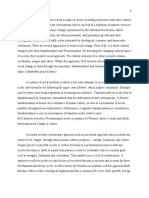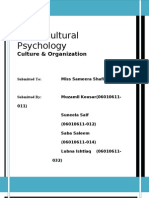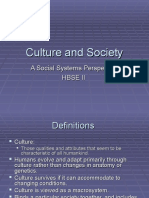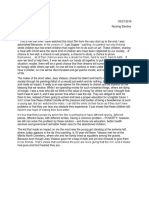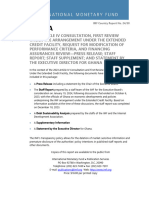0 ratings0% found this document useful (0 votes)
8 viewsMovement Essay
Movement Essay
Uploaded by
manufaceconsultantsessay
Copyright:
© All Rights Reserved
Available Formats
Download as DOCX, PDF, TXT or read online from Scribd
Movement Essay
Movement Essay
Uploaded by
manufaceconsultants0 ratings0% found this document useful (0 votes)
8 views2 pagesessay
Original Title
movement essay
Copyright
© © All Rights Reserved
Available Formats
DOCX, PDF, TXT or read online from Scribd
Share this document
Did you find this document useful?
Is this content inappropriate?
essay
Copyright:
© All Rights Reserved
Available Formats
Download as DOCX, PDF, TXT or read online from Scribd
Download as docx, pdf, or txt
0 ratings0% found this document useful (0 votes)
8 views2 pagesMovement Essay
Movement Essay
Uploaded by
manufaceconsultantsessay
Copyright:
© All Rights Reserved
Available Formats
Download as DOCX, PDF, TXT or read online from Scribd
Download as docx, pdf, or txt
You are on page 1of 2
Movement
The Dynamics and Significance of Movement
Movement is a fundamental aspect of existence, permeating all facets of life, from the
physical locomotion of organisms to the dynamic shifts in social and cultural contexts. It is a
concept that encompasses various dimensions, including biological, psychological, social,
and metaphorical realms. Understanding movement involves examining its mechanisms,
significance, and impact on both individuals and societies. This essay explores the nature of
movement, its underlying principles, and its broader implications across different contexts.
Biological Foundations of Movement
At its most basic level, movement is a biological phenomenon. In the animal kingdom,
movement is essential for survival, encompassing locomotion, foraging, reproduction, and
defense. The ability to move allows organisms to navigate their environments, seek resources,
and avoid predators. The mechanics of movement involve complex interactions between
muscles, bones, and the nervous system.
In humans, movement is facilitated by a sophisticated musculoskeletal system and controlled
by the brain and spinal cord. The study of biomechanics reveals how forces are applied and
resisted during various activities, from walking and running to intricate dance movements.
The coordination of muscles and joints, guided by neural signals, enables precise and
adaptive movements necessary for daily functions and athletic performance.
Moreover, movement plays a crucial role in human health. Regular physical activity is linked
to numerous benefits, including improved cardiovascular health, enhanced mood, and
cognitive function. Exercise and movement therapies are integral to rehabilitation and
maintaining overall well-being.
Psychological and Cognitive Aspects
Movement is not only a physical process but also deeply intertwined with psychological and
cognitive functions. The ability to move impacts mental health and cognitive development.
For instance, physical activity has been shown to alleviate symptoms of depression and
anxiety, enhance cognitive function, and support emotional regulation.
The psychological concept of "motor learning" refers to how individuals acquire and refine
movement skills through practice and experience. This process is essential for developing
coordination, balance, and complex motor tasks. Additionally, movement plays a significant
role in cognitive development, particularly in children. Activities that involve physical
exploration and manipulation contribute to learning and problem-solving skills.
Movement also influences our emotional and psychological states. The act of moving—
whether through dance, sports, or simple gestures—can express and affect emotions. The
body’s movements often mirror our inner experiences, and engaging in physical activities can
serve as a form of emotional release and self-expression.
Social and Cultural Dimensions
Movement extends beyond the individual to encompass social and cultural dimensions.
Social movements, for example, represent collective efforts to address societal issues and
effect change. Historical and contemporary social movements—such as the Civil Rights
Movement, feminist movements, and environmental advocacy—demonstrate how organized
efforts and collective actions can reshape societies and address injustices.
Cultural practices and rituals often involve movement, reflecting and reinforcing societal
values and norms. Dance, for instance, serves as both a form of artistic expression and a
means of cultural transmission. Various cultures have developed unique dance styles and
movements that convey stories, traditions, and identity.
In the context of globalization and technological advancement, movement takes on new
forms. The rapid exchange of information, ideas, and people across borders exemplifies the
dynamic nature of modern societies. Migration, travel, and virtual connectivity facilitate
cultural exchange and influence, shaping contemporary social and cultural landscapes.
Metaphorical and Philosophical Perspectives
Movement also has profound metaphorical and philosophical implications. The concept of
movement can symbolize progress, change, and transformation. In philosophical terms,
movement often represents the dynamic and evolving nature of existence. Heraclitus, a pre-
Socratic philosopher, famously posited that "change is the only constant," emphasizing the
inevitability of movement and transformation in life.
Metaphorically, movement can signify personal growth and development. The journey of
self-improvement and the pursuit of goals are often described as a process of movement and
evolution. The idea of "moving forward" in life captures the essence of striving for progress
and overcoming obstacles.
Conclusion
Movement is a multifaceted concept that encompasses biological, psychological, social,
cultural, and philosophical dimensions. It is fundamental to life, influencing how organisms
interact with their environments, how individuals experience their emotions and cognitive
functions, and how societies evolve and respond to change. By understanding the various
aspects of movement, we gain insight into its significance and impact on both personal and
collective levels. Movement, in its many forms, reflects the dynamic and ever-changing
nature of existence, shaping our experiences and defining our interactions with the world.
You might also like
- Behaviorism and EducationDocument57 pagesBehaviorism and EducationEllaine Grace Delima Gurro100% (2)
- Kine To LogieDocument62 pagesKine To LogieMarinescu ValentinNo ratings yet
- Sudakov 1997 The Theory of Functional Systems General PrinciplesDocument23 pagesSudakov 1997 The Theory of Functional Systems General PrinciplesAvengingBrainNo ratings yet
- Wills Succession Atty. Sebastian Lecture NotesDocument71 pagesWills Succession Atty. Sebastian Lecture Notesroa yusonNo ratings yet
- Human Research Can EvolveDocument2 pagesHuman Research Can EvolveLeonardoNo ratings yet
- Life EssayDocument2 pagesLife EssaymanufaceconsultantsNo ratings yet
- What Is The Human Behavior PDFDocument14 pagesWhat Is The Human Behavior PDF21UG1350 Tharushi WeerasingheNo ratings yet
- Social Behavior: Prof. Maria Krisia Fae R. de AsisDocument12 pagesSocial Behavior: Prof. Maria Krisia Fae R. de AsisKri de AsisNo ratings yet
- Factors That Influence Human Behaviour or Indicators of BehaviourDocument8 pagesFactors That Influence Human Behaviour or Indicators of BehaviourSalma LyambilaNo ratings yet
- Assignment 01 Pyc4805Document2 pagesAssignment 01 Pyc4805nancyNo ratings yet
- Lesson 2 - Human BioculturalDocument34 pagesLesson 2 - Human BioculturalVanessa Tamayo, Ph. DNo ratings yet
- Social ChangeDocument4 pagesSocial ChangeNgawang NorbuNo ratings yet
- Uts Scientific Views of The SelfDocument3 pagesUts Scientific Views of The SelfAllysah Aloc KimNo ratings yet
- Perspectives in PsychologyDocument4 pagesPerspectives in PsychologyChaudhary Muhammad Talha Naseer100% (1)
- Human Behavior Chapter 7Document11 pagesHuman Behavior Chapter 7Messi chekoleNo ratings yet
- Young Adulthood Development 20 40 YearsDocument22 pagesYoung Adulthood Development 20 40 YearsHoang AnhNo ratings yet
- Health Related Fitness: Reaction TimeDocument4 pagesHealth Related Fitness: Reaction TimeAva BarramedaNo ratings yet
- Cultural Impact On Human Behavior: Psychology For Engineers 2021Document4 pagesCultural Impact On Human Behavior: Psychology For Engineers 2021Arosha RohanapuraNo ratings yet
- Life Span DevelopmentDocument2 pagesLife Span Developmentcharmaine SalasNo ratings yet
- Mitochondria Class NotesDocument3 pagesMitochondria Class Notesjohnjoshuaramirez.officialNo ratings yet
- Unit 1 Social ScienceDocument15 pagesUnit 1 Social ScienceZara EdwardsNo ratings yet
- Behaviour NewDocument46 pagesBehaviour Newbcsnngq8m2No ratings yet
- The Kinesthetic SystemDocument8 pagesThe Kinesthetic SystemCANDELA SALGADO IVANICHNo ratings yet
- Culture and How It Defines Moral BehaviorDocument7 pagesCulture and How It Defines Moral BehaviorJazmin Jade EscolanoNo ratings yet
- Indoaryan Existentialism: A Scientific Path of DivineCommunismDocument6 pagesIndoaryan Existentialism: A Scientific Path of DivineCommunismDr. Srikumar MukherjeeNo ratings yet
- Reviewer of Ucsp 2019Document5 pagesReviewer of Ucsp 2019rizalyn alegreNo ratings yet
- Definition of AntropologyDocument3 pagesDefinition of Antropologyrussel kyleNo ratings yet
- Culture, Symbols, and Human Brain Evolution: A Synthesis: Social BehaviorDocument17 pagesCulture, Symbols, and Human Brain Evolution: A Synthesis: Social BehavioraerxinNo ratings yet
- Culture and SocietyDocument22 pagesCulture and SocietykonstantasNo ratings yet
- Culture & OrganizationDocument26 pagesCulture & OrganizationMuzamilNo ratings yet
- Social Change and Media - Taimoor TKDocument44 pagesSocial Change and Media - Taimoor TKmuhammadtaimoorkhan100% (2)
- Pre Final in GE IDocument12 pagesPre Final in GE IShiela mae LasalaNo ratings yet
- Anthropology Sociology Political Science-170330073722Document30 pagesAnthropology Sociology Political Science-170330073722Mary Rose Divinagracia-FloresNo ratings yet
- 9 - Rizwan Ullah Kokab - v51 - 2Document20 pages9 - Rizwan Ullah Kokab - v51 - 2makhdoomnasirhNo ratings yet
- Human FlorishingDocument10 pagesHuman FlorishingLei-Angelika TungpalanNo ratings yet
- Culture and SocietyDocument22 pagesCulture and SocietyReina Anne JaymeNo ratings yet
- Foundation of GuidanceDocument17 pagesFoundation of GuidanceFroilan FerrerNo ratings yet
- Document (2) - 3 PDFDocument16 pagesDocument (2) - 3 PDFSaima GousNo ratings yet
- Bijou, S. W. (1984) - Cross-Sectional and Longitudinal Analysis of Development. The Interbehavioral PerspectiveDocument11 pagesBijou, S. W. (1984) - Cross-Sectional and Longitudinal Analysis of Development. The Interbehavioral PerspectiveFreddy Molero-RamírezNo ratings yet
- Scientific Views About The SelfDocument16 pagesScientific Views About The Selfarmyahgase 11No ratings yet
- Sociology-Chapter OneDocument24 pagesSociology-Chapter Onefasil mamoNo ratings yet
- UCSP Notes Sociological Imagination and Theoretical Perspectives - Yiela LimDocument10 pagesUCSP Notes Sociological Imagination and Theoretical Perspectives - Yiela Limf l o u n d e rNo ratings yet
- Chapter I IntroductionDocument38 pagesChapter I IntroductionThe greatest familyNo ratings yet
- Culture and Society 4Document20 pagesCulture and Society 4Faryal ArifNo ratings yet
- Affect: Lisa Blackman and Couze VennDocument22 pagesAffect: Lisa Blackman and Couze VennaxiomatizadorrNo ratings yet
- GST Lecture Note 1Document9 pagesGST Lecture Note 1ejerajosiah38No ratings yet
- Understanding The Self Chapter 2 Lesson 1Document10 pagesUnderstanding The Self Chapter 2 Lesson 1MASHNo ratings yet
- UTS Anthropological Perspective of The SelfDocument28 pagesUTS Anthropological Perspective of The SelfThraia Gabriella MercadejasNo ratings yet
- Life Span Development-NotesDocument22 pagesLife Span Development-Notesdisapanneet21No ratings yet
- Ritual and Social ChangeDocument2 pagesRitual and Social ChangeLoh Chia PeiNo ratings yet
- Introduction To Philosophy of Human PersonDocument3 pagesIntroduction To Philosophy of Human PersonBianca Nathalie NicolNo ratings yet
- Exploring The Vastness of Space An Overview of Key Concepts and DiscoveriesDocument5 pagesExploring The Vastness of Space An Overview of Key Concepts and Discoveriesemranhossan960No ratings yet
- Meaning and Definition of CultureDocument2 pagesMeaning and Definition of CultureNicole Dela Cruz BaquiranNo ratings yet
- Social Problems and Social ChangeDocument57 pagesSocial Problems and Social ChangeJayvee Ayeras100% (1)
- Shuenn-Der Yu - Bodily Cultivation As A Mode of LearningDocument10 pagesShuenn-Der Yu - Bodily Cultivation As A Mode of LearningnqngestionNo ratings yet
- Social ChangeDocument57 pagesSocial ChangeGad GerancoNo ratings yet
- List #2: Articulating Effortlessness and Non-Violence in Movement PracticeDocument21 pagesList #2: Articulating Effortlessness and Non-Violence in Movement Practiceapi-249278978No ratings yet
- Theme 1 Human DevelopmentDocument4 pagesTheme 1 Human Developmentmatguay9No ratings yet
- Handouts Week 5Document5 pagesHandouts Week 5ahyahxdxdNo ratings yet
- Ucsp 22Document53 pagesUcsp 22Ariel PagoboNo ratings yet
- Imagination Versus Reality: Navigating the Realms of Human ExperienceFrom EverandImagination Versus Reality: Navigating the Realms of Human ExperienceNo ratings yet
- Thematic Map - Wikipedia, The Free EncyclopediaDocument5 pagesThematic Map - Wikipedia, The Free EncyclopediaAnthony AngelesNo ratings yet
- Untitled StoryDocument17 pagesUntitled StoryJas CalzadoNo ratings yet
- Course Code: BP603T Course Title: Herbal Drug TechnologyDocument18 pagesCourse Code: BP603T Course Title: Herbal Drug TechnologyRohan SinghNo ratings yet
- Laceration Repair: A Practical Approach: Randall T. Forsch, MD, MPH Sahoko H. Little, MD, PHD and Christa Williams, MDDocument10 pagesLaceration Repair: A Practical Approach: Randall T. Forsch, MD, MPH Sahoko H. Little, MD, PHD and Christa Williams, MDLeonardoCampanelliNo ratings yet
- CHN Notes National Part 1Document39 pagesCHN Notes National Part 1Justine Ingrid O. FernandezNo ratings yet
- Chapter 9-Selection From Outside The Service: Julie Ann L. MayorDocument17 pagesChapter 9-Selection From Outside The Service: Julie Ann L. MayorHul YanaNo ratings yet
- Lecture 02b Oxidation-ReductionDocument41 pagesLecture 02b Oxidation-ReductionVivi AisahNo ratings yet
- Newsletter December 2014Document10 pagesNewsletter December 2014api-242081048No ratings yet
- Input Output Questions Specially For Sbi Po PrelimsDocument17 pagesInput Output Questions Specially For Sbi Po PrelimsAanchal KulshresthaNo ratings yet
- The Influence of Social Interactions On The Behavioral Patterns of The PeopleDocument16 pagesThe Influence of Social Interactions On The Behavioral Patterns of The PeopleFrod 22No ratings yet
- Pathophysiology of FeverDocument4 pagesPathophysiology of FeverEasha Jamil AbbasiNo ratings yet
- Mhzentul PDFDocument17 pagesMhzentul PDFArcojinNo ratings yet
- Kambas NG LipunanDocument1 pageKambas NG LipunanNyeam NyeamNo ratings yet
- Economics: A2 Skills, Extension MaterialDocument39 pagesEconomics: A2 Skills, Extension MaterialInderMaheshNo ratings yet
- Chemiosmotic Theory June 2013Document2 pagesChemiosmotic Theory June 2013Marian AlexNo ratings yet
- Third Conditional Lesson PlanDocument3 pagesThird Conditional Lesson Planaliciacg67No ratings yet
- Language Assessment: Education in 2500 Words LengthDocument2 pagesLanguage Assessment: Education in 2500 Words Lengthwayan suastikaNo ratings yet
- Salesforce Question & AnswersDocument17 pagesSalesforce Question & AnswersAjay Chowdary Ajay ChowdaryNo ratings yet
- Urdaneta City University San Vicente West, Urdaneta City College of Engineering and ArchitectureDocument41 pagesUrdaneta City University San Vicente West, Urdaneta City College of Engineering and ArchitectureDAWFWFNo ratings yet
- Edwin Lutyens Case StudyDocument16 pagesEdwin Lutyens Case StudyDhriti JainNo ratings yet
- Ariauna Heck ResumeDocument2 pagesAriauna Heck Resumeapi-283407086No ratings yet
- IMF GHANA REPORT January 2023Document155 pagesIMF GHANA REPORT January 2023The Independent Ghana100% (2)
- I Want You Back: Q 100, Latin FunkDocument1 pageI Want You Back: Q 100, Latin FunkBilbohicks2014No ratings yet
- Biology Class: 11 Unit: 1Document8 pagesBiology Class: 11 Unit: 1samiNo ratings yet
- Komatsu Hydraulic Excavator Pc850se 8 Shop ManualDocument20 pagesKomatsu Hydraulic Excavator Pc850se 8 Shop Manualleon100% (56)
- Jurnal Tesis 25Document15 pagesJurnal Tesis 25Fadel KurniawanNo ratings yet
- LAB3Document24 pagesLAB3Kerr GenebraldoNo ratings yet
- The Dirac Equation and Prediciton of AntimatterDocument11 pagesThe Dirac Equation and Prediciton of AntimatterDirect55No ratings yet











